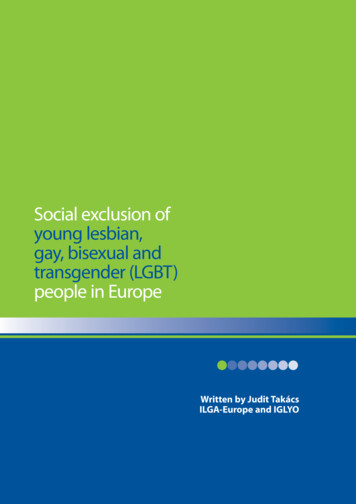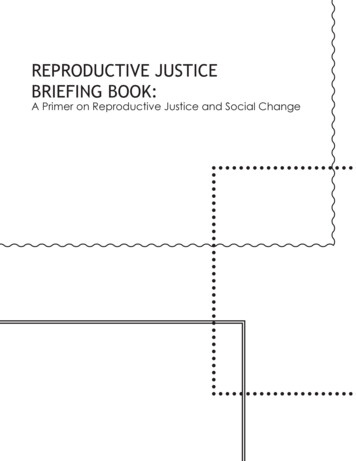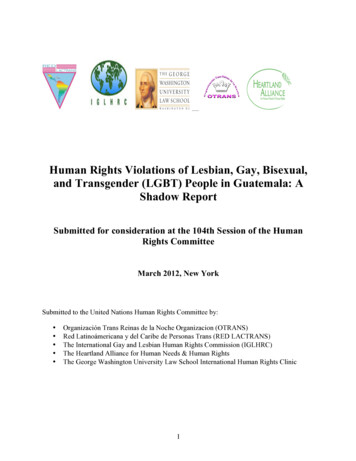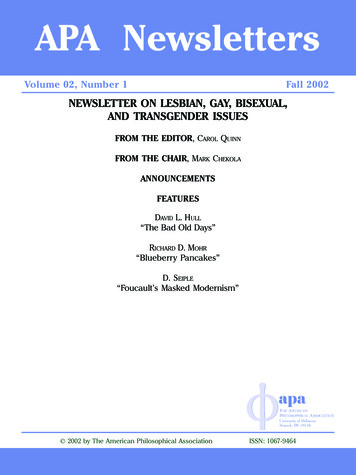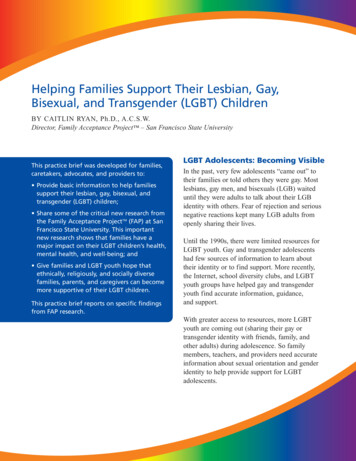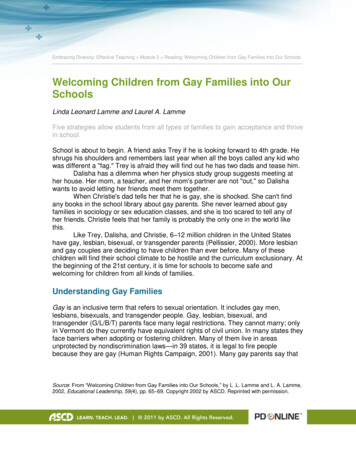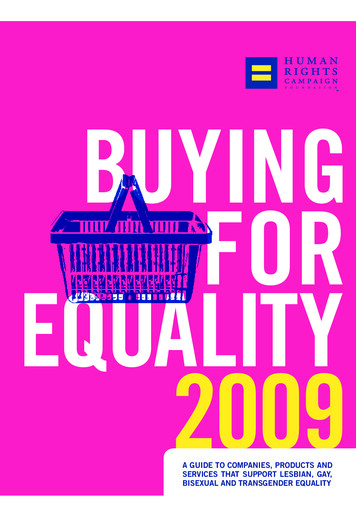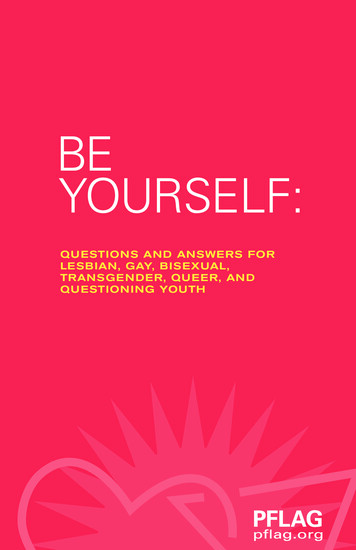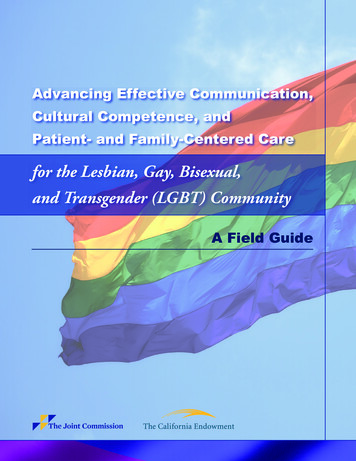
Transcription
GYDQFLQJ (IIHFWLYH &RPPXQLFDWLRQ &XOWXUDO &RPSHWHQFH DQG 3DWLHQW DQG )DPLO\ &HQWHUHG &DUHfor the Lesbian, Gay, Bisexual,and Transgender (LGBT) Community )LHOG *XLGH
Advancing Effective Communication, Cultural Competence, and Patient- and Family-Centered Carefor the Lesbian, Gay, Bisexual, and Transgender (LGBT) CommunityJoint Commission ContributorsBrette Tschurtz (Lead)Associate Project DirectorDivision of Healthcare Quality EvaluationAnn BurkeConsultantDivision of Healthcare Quality EvaluationExternal Project AdvisorsIgnatius Bau, JDHealth Policy ConsultantIlene Corina, PresidentPULSE of New York, Inc.Public Member, Joint Commission Board of CommissionersFred Hobby, President and CEOInstitute for Diversity in Health ManagementAmerican Hospital AssociationShane SnowdonDirector, Center for LGBT Health & EquityUniversity of California, San FranciscoTom SullivanHuman Rights Campaign FoundationDeputy Director, Family ProjectAmy Wilson-Stronks, MPP, CPHQIndependent Advocate, Consultant, and ResearcherThe Joint Commission MissionThe mission of The Joint Commission is to continuouslyimprove health care for the public, in collaboration withother stakeholders, by evaluating health care organizationsand inspiring them to excel in providing safe and effectivecare of the highest quality and value.DisclaimerThe Joint Commission project staff is solely responsible forthe content of this monograph. This monograph is informedby the research conducted by the project staff, and therecommendations of our expert advisory panel and stakeholder group. Published literature as well as informationiireferred by our stakeholder group, project advisors, reviewers,and collaborating organizations were considered. However,the inclusion of any reference or example should not beconstrued as an endorsement by The Joint Commission orby the project expert panel and stakeholder group or anyof its members, of any specific method, product, treatment,practice, program, service, vendor, or resource.We hope this monograph contains useful information, butit is not intended to be a comprehensive source for allrelevant information. The Joint Commission and its collaborating organizations are not responsible for any claimsor losses arising from the use of, or from any errors oromissions in, this monograph.The inclusion of an organization name, product, or servicein a Joint Commission publication should not be construed as an endorsement of such organization, product,or service, nor is failure to include an organization name,product, or service to be construed as disapproval. 2011 The Joint CommissionPermission to reproduce this guide for noncommercial,educational purposes with displays of attribution is granted.For other requests regarding permission to reprint, pleasecall 630-792-5957.Printed in the U.S.A. 5 4 3 2 1Requests for permission to reprint copies of any partof this work should be mailed toDivision of Healthcare Quality EvaluationThe Joint CommissionOne Renaissance BoulevardOakbrook Terrace, Illinois 60181Suggested Citation:The Joint Commission: Advancing Effective Communication, Cultural Competence, and Patient- and FamilyCentered Care for the Lesbian, Gay, Bisexual, and Transgender (LGBT) Community: A Field Guide. Oak Brook, IL,Oct. 2011. LGBTFieldGuide.pdf.For more information about The Joint Commission, pleasevisit http://www.jointcommission.org.
CONTENTSAcknowledgmentsvIntroduction1About The Joint CommissionDevelopment of the LGBT Field GuideTerminologyHow to Use This GuideChapter 1: Leadership24457Chapter 2: Provision of Care, Treatment, and Services11Chapter 3: Workforce19Chapter 4: Data Collection and Use25Chapter 5: Patient, Family, and Community Engagement31Appendix A: Checklists to Advance Effective Communication, CulturalCompetence, and Patient- and Family-Centered Care for the Lesbian,Gay, Bisexual, and Transgender (LGBT) Community35Appendix B: Joint Commission Requirements Supporting EffectiveCommunication, Cultural Competence, and Patient- andFamily-Centered Care41Appendix C: Laws, Regulations, and Executive Materials51Appendix D: Resource Guide71Glossary87iii
Advancing Effective Communication, Cultural Competence, and Patient- and Family-Centered Carefor the Lesbian, Gay, Bisexual, and Transgender (LGBT) Communityiv
&.12:/('*0(176We would like to thank The California Endowment for generously funding this project. Special thanks to DianneYamashiro-Omi, program manager, Equity and Diversity, at The California Endowment for her continued support.Editorial and Production Support,JQDWLXV %DX -' 3URMHFW GYLVRU HDOWK 3ROLF\ &RQVXOWDQW0DQ\ WKDQNV IRU WKH HGLWRULDO VXSSRUW RI HOHQ )U\ 0 PDQDJHU DQG ,OHVH &KDWPDQ VHQLRU HGLWRU -RLQW &RP PLVVLRQ 5HVRXUFHV DQG IRU WKH GHVLJQ DQG SURGXFWLRQ VNLOOV RI %ULGJHW &KDPEHUV SURMHFW PDQDJHU -RLQW &RP PLVVLRQ 5HVRXUFHV 7DUD %RUHOOL -'6WDII WWRUQH\/DPEGD /HJDOSpecial Thanks-XG\ %UDGIRUG 3K''LUHFWRU &HQWHU IRU 3RSXODWLRQ 5HVHDUFK LQ /*%7 HDOWK7KH )HQZD\ ,QVWLWXWH7KDQNV WR .HOODQ %DNHU 03 0 &HQWHU IRU PHULFDQ 3URJUHVV DQG 6KDQH 6QRZGRQ 8QLYHUVLW\ RI &DOLIRUQLD 6DQ )UDQFLVFR &HQWHU IRU /*%7 HDOWK (TXLW\ IRU DVVLVWDQFH ZLWK PDQXVFULSW GHYHORSPHQW 7KDQN \RX WR 7DUD %RUHOOL -' DW /DPEGD /HJDO /HVOLH &DOPDQ 3K'0DXWQHU 3URMHFW 7KH 1DWLRQDO /HVELDQ HDOWK 2UJDQL]DWLRQ7KDQNV DOVR WR %HYHUO\ 7LOOHU\ DQG 5\DQ *UXEV DW /DPEGD /HJDO ,OOLQRLV 0DVRQLF 0HGLFDO &HQWHU /L] 0DUJROLV &KDG 3XWPDQ 6FRXW 3K' ,OHQH &RULQD 6KDQH 6QRZGRQ 7RP 6XOOLYDQ DOO WKH SDUWLFLSDQWV RQ WKH ([SHUW GYLVRU\ 3DQHO DQG WKH GR]HQV RI SHUVRQV LQ WKH ¿HOG ZKR VKDUHG WHVWLPR QLDOV DQG H[DPSOHV RI KHDOWK FDUH H[SHULHQFHV 6HYHUDO VWDII DW 7KH -RLQW &RPPLVVLRQ FRQWULEXWHG VXEVWDQWLDO WLPH DQG HIIRUW WR WKLV SURMHFW LQFOXGLQJ -HURG /RHE 3K' 5LFKDUG .RVV 0 6FRWW :LOOLDPV 3V\' 7LQD &RUGHUR 3K' 03 -DQ .HQGULFN 0 .ULVWLQH 'RQRIULR DQG 7DVKD 0HDUGD\ 7KHLU FRQWULEXWLRQV ZHUH LQYDOXDEOH WR WKLV SURMHFW :H ZRXOG OLNH WR DFNQRZOHGJH WKH 'HSDUWPHQW RI 6WDQGDUGV DQG 6XUYH\ 0HWKRGV IRU WKHLU WKRXJKWIXO UHYLHZ RI SSHQGL[ % Expert Advisory Panel.HOODQ ( %DNHU 03 0 HDOWK 3ROLF\ QDO\VW&HQWHU IRU PHULFDQ 3URJUHVV)RUPHUO\ ZLWK 7KH 1DWLRQDO &RDOLWLRQ IRU /*%7 HDOWK&HFLOLD &KXQJ&KDLU 6DQ )UDQFLVFR XPDQ 5LJKWV &RPPLVVLRQ.LQQHLO &ROWPDQ 0 'LUHFWRU RI 'LYHUVLW\ DQG /DQJXDJH 6HUYLFHV*UHHQYLOOH RVSLWDO 6\VWHP 8QLYHUVLW\ 0HGLFDO &HQWHU,OHQH &RULQD 3URMHFW GYLVRU3DWLHQW 6DIHW\ &RQVXOWDQW3UHVLGHQW 38/6( RI 1HZ RUN ,QF 3XEOLF 0HPEHU RI WKH -RLQW &RPPLVVLRQ %RDUG RI &RPPLVVLRQHUV0RQLFD )HLW 3K' 03 6HQLRU 3URJUDP 2I¿FHU,QVWLWXWH RI 0HGLFLQH5HEHFFD )R[)RUPHU ([HFXWLYH 'LUHFWRU7KH 1DWLRQDO &RDOLWLRQ IRU /*%7 HDOWKY
Advancing Effective Communication, Cultural Competence, and Patient- and Family-Centered Carefor the Lesbian, Gay, Bisexual, and Transgender (LGBT) CommunityRob Garofalo, MD, MPHDirector, Adolescent HIV ServicesChildren’s Memorial HospitalAssociate Professor of Pediatrics and PreventiveMedicineNorthwestern University Feinberg School of MedicineDaniel Gould, LCSWNetwork CoordinatorCalifornia LGBT Health and Human Services NetworkEquality California: Equality California InstituteSusan W. Haikalis, LCSWSocial Work ConsultantChair, Patient and Family Advisory Council ofThe Joint CommissionKay Heggestad, MDParents, Families and Friends of Lesbians and Gays(PFLAG)Board Member and Regional Director Northern PlainsFred Hobby, MA (Project Advisor)President and CEOInstitute for Diversity in Health ManagementAmerican Hospital AssociationKenneth D. Johnson, JDOffice for Civil RightsU.S. Department of Health and Human ServicesRobert C. Like, MD, MSProfessor and Director, Center for Healthy Families andCultural DiversityDepartment of Family Medicine and Community HealthUMDNJ – Robert Wood Johnson Medical SchoolviAnita Radix, MD, MPHAssociate Medical DirectorCallen-Lorde Community Health CenterShane Snowdon (Project Advisor)Director, Center for LGBT Health & EquityUniversity of California, San FranciscoTom Sullivan (Project Advisor)Deputy Director, Family ProjectHuman Rights Campaign FoundationHector Vargas, JDExecutive DirectorGay and Lesbian Medical Association (GLMA)Serena WorthingtonDirector, Community Advocacy and Capacity BuildingSAGE (Services and Advocacy for Gay, Lesbian,Bisexual and Transgender Elders)Amy Wilson-Stronks, MPP, CPHQ (Project Advisor)Independent Advocate, Consultant, and ResearcherMatthew K. Wynia, MD, MPH, FACPDirector, Institute for Ethics and the Center forPatient SafetyAmerican Medical Association
INTRODUCTIONThe role of effective communication andpatient-centeredness in providing safe andhigh-quality health care to diverse patientpopulations is well accepted. Effectivepatient–provider communication has beenlinked to an increase in patient satisfaction,better adherence to treatment recommendations, and improved health outcomes.1Patient-centered care “encompasses qualitiesof compassion, empathy, and responsivenessto the needs, values, and expressed preferences of the individual patient.”2 (p.48) Combining the elements of effective communicationand patient-centeredness into care deliveryhas been shown to improve patients’ healthand health care.3Many resources and initiatives have beendevoted to assist hospitals in efforts toadvance cultural competence, improve communication, and provide equitable and morepatient-centered care to several diversepatient populations. However, until recently,patients who are lesbian, gay, bisexual, andtransgender (LGBT) have been an often overlooked community of health care consumers.LGBT people and their families reside inevery county in the United States. The LGBTcommunity is as diverse as the nation andincludes members of every race, ethnicity,religion, mental capacity, physical ability/disability, age, and socioeconomic group.4Although estimates vary, approximately 3.5%of American adults identify as lesbian, gay,or bisexual, while 0.3% are transgender.5 Notonly do the members of this community sharethe health concerns of the rest of the population, they also face a number of significantadditional health risks.Like many other populations identified asat-risk or disadvantaged, research hasdemonstrated that LGBT individuals experience disparities not only in the prevalenceof certain physical and mental health concerns, but also in care due to a variety offactors, including experiences of stigma,lack of awareness, and insensitivity to theirunique needs.6 These disparities include thefollowing7–9: Less access to insurance and health careservices, including preventive care (suchas cancer screenings) Lower overall health status Higher rates of smoking, alcohol, andsubstance abuse Higher risk for mental health illnesses,such as anxiety and depression Higher rates of sexually transmitteddiseases, including HIV infection Increased incidence of some cancersIn addition, LGBT patients face other barriersto equitable care, such as refusals of care,delayed or substandard care, mistreatment,inequitable policies and practices, little or noinclusion in health outreach or education, andinappropriate restrictions or limits on visitation.9 These inequalities may be even morepronounced for LGBT people from racial/ethnicminorities10 or due to other characteristics suchas education level, income, geographic location, language, immigration status, and culturalbeliefs. Experiences of discrimination andmistreatment have, in many cases, contributedto a long-standing distrust of the health caresystem by many in the LGBT community andhave affected their health in profound ways.6Many groups have worked to increase awareness and focus efforts at the national, state,local, and organization levels to better understand the health care needs of the LGBTcommunity, the persistence of stigma and discrimination, and the need for more data andANote AboutTerminologyWhile each letterof the acronymLGBT refers to adistinct populationwith unique needs,this field guide usesLGBT as an umbrellaterm to refer to thecommunity as awhole. Lesbian, gay,and bisexual refer tosexual orientation—transgender refersto an individual’sgender identity orgender expression.Transgender is usedin this guide to referto individuals whosegender identity orgender expressiondiffers from theirassigned sex at birthor any prevailingideas of masculinityor femininity (see“Terminology” inthis section and theGlossary for expandeddefinitions).1
Advancing Effective Communication, Cultural Competence, and Patient- and Family-Centered Carefor the Lesbian, Gay, Bisexual, and Transgender (LGBT) Communityinformation about LGBT population healthand practices. Although this work has resultedin recent federal, state, and local initiativesand recommendations that are designed toobtain more information and to improve thecare provided to the LGBT population (seeAppendix C, “Laws, Regulations, and Executive Materials,” page 51), we cannot affordto wait for these recommendations to takehold before we begin to address the needs ofLGBT patients and families. In the health caresetting—an environment that is already asource of considerable fear, stress, and anxiety—LGBT patients today too often bear theadditional burdens of discrimination and feeling unwelcome, vulnerable, and invisible.11Fortunately, there are practices and strategiesthat health care providers and hospitals canimplement to begin building trust and makingthe health care environment more welcoming, inclusive, and safe for LGBT patients andtheir families.To ensure quality care, all patients, regardlessof social or personal characteristics, shouldbe treated with dignity and respect in healthcare settings and should feel comfortable providing any information relevant to their care,including information about sexual orientation and gender identity. This field guide is acompilation of strategies, practice examples,resources, and testimonials designed toassist hospital staff in improving quality ofcare by enhancing their efforts to provide carethat is more welcoming, safe, and inclusive ofLGBT patients and families.About The Joint CommissionSince its inception, The Joint Commissionhas promoted nondiscrimination in patientcare and every day works toward fulfilling thevision that “all people always experience thesafest, highest quality, best value health careacross all settings.”12 The Joint Commissioncontinually strives to better understand the2needs of individual patients and populationsas they relate to health care disparities andto provide guidance for hospitals as theyattempt to provide patient- and familycentered care.13 Many initiatives and effortshave been made, past and present, towardthis end (see Table 1-1, “Time Line: JointCommission Efforts Past and Present,” onpage 3).In 2011, new and revised standards designedto promote patient-centered communicationwere published in the Joint Commission’sComprehensive Accreditation Manual forHospitals (see Appendix B, page 41). Thepatient-centered communication standardsinclude revised elements of performancethat prohibit discrimination based on sexualorientation, gender identity, and genderexpression, and that ensure access to asupport person of the patient’s choice, whichare critical issues to the LGBT community. Inaddition to the revised standards, The JointCommission published Advancing EffectiveCommunication, Cultural Competence, andPatient- and Family-Centered Care: A Roadmap for Hospitals in August 2010. This comprehensive document is intended to inspirehospital staff to integrate concepts from thefields of communication, cultural competence,and patient- and family-centered care intoorganizations. The Roadmap for Hospitalscontains recommendations specific to theLGBT population, including an inclusive definition of family, and also provides resourcesrelated to the care of LGBT patients.13Although Joint Commission standards andA Roadmap for Hospitals are designed toencompass many salient issues in LGBThealth care, the need to provide more information, guidance, and education to healthcare organizations to address specific LGBTissues was apparent. In January 2010, withfunding from The California Endowment, TheJoint Commission began to build on its efforts
INTRODUCTIONTable 1-1. Time Line: Joint Commission Efforts Past and Present2003In 2003, The Joint Commission conducted a gap analysis of its accreditation standards in comparison to theOffice of Minority Health’s National Standards for Culturally and Linguistically Appropriate Services (CLAS). Theresults indicated that although there were many Joint Commission standards that addressed the issues highlighted in the CLAS standards, the requirements were less prescriptive.2004The Joint Commission, with funding from The California Endowment, began the Hospitals, Language, and Culture: A Snapshot of the Nation (HLC) study in 2004. The HLC study was a qualitative cross-sectional researchproject that explored how 60 hospitals nationwide provide care to culturally and linguistically diverse patientpopulations.2005As part of a public policy initiative, The Joint Commission convened a Health Literacy and Patient Safety Roundtable in 2005. The Roundtable resulted in the publication of the white paper, What Did the Doctor Say? Improving Health Literacy to Protect Patient Safety. This white paper presented recommendations and interventions toimprove patient understanding of complex medical information for individuals with low health literacy or limitedEnglish proficiency (LEP).2007The HLC study released its first research report in March 2007, Exploring Cultural and Linguistic Services in theNation’s Hospitals: A Report of Findings. The report provided insight into the challenges, activities, and perspectives of hospitals and contained recommendations for hospitals, policymakers, and researchers to improve careto diverse populations. Findings are presented within the context of a research framework, which includes thefollowing domains: leadership, quality improvement and data use, workforce, patient safety and provision ofcare, language services, and community engagement.2007The Joint Commission received funding from The Commonwealth Fund to examine the characteristics (forexample, impact, type, causes) of adverse events for LEP and English-speaking patients. Based on adverseevent data from six Joint Commission–accredited hospitals, LEP patients were more likely to experienceadverse events with detectable harm than English-speaking patients. The adverse events experienced by LEPpatients were also more frequently caused by communication errors than for English-speaking patients. Thisstudy was published in the February 2007 International Journal for Quality in Health Care in an article titled “Language proficiency and adverse events in U.S. hospitals: A pilot study”.2008The second HLC report, One Size Does Not Fit All: Meeting the Health Care Needs of Diverse Populations,presented current practices that hospitals are using to provide care and services to diverse patients. This report,released in April 2008, includes a self-assessment tool that organizations can use to initiate discussions abouttheir needs, resources, and goals for providing the highest quality care to every patient served.2008In 2008, The Joint Commission, with funding from The Commonwealth Fund, began the development ofaccreditation requirements for hospitals to advance the issues of effective communication, cultural competence,and patient- and family-centered care. The project was designed to improve the safety and quality of care for allpatients through new and revised accreditation requirements and to inspire hospitals to adopt practices promoting patient-centered communication.2009In October 2009, The Joint Commission’s Standards and Survey Procedures Committee of the Board of Commissioners approved new and revised standards for patient-centered communication. The patient centeredstandards are discussed in Appendix B.2010The Joint Commission published a monograph to help hospitals integrate communication, cultural competence,and patient- and family-centered care practices into their organizations. The monograph, titled Advancing Effective Communication, Cultural Competence, and Patient- and Family-Centered Care: A Roadmap for Hospitals,was supported by a grant from The Commonwealth Fund. In September of 2010, with funding from The California Endowment, The Joint commission convened a panel of stakeholders to discuss the promotion of effectivecommunication, cultural competence, and patient- and family-centered care specifically to the lesbian, gay,bisexual, and transgender (LGBT) community.2011The patient-centered communication standards were published in the 2011 Comprehensive AccreditationManual for Hospitals (CAMH). Surveyors began evaluating compliance with these standards in January 1, 2011,but findings were not factored into an organization’s accreditation decision until July 1, 2012. However, elementsof performance 28 and 29 under RI.01.01.01, which require access to a support person and non-discriminationof care, had an earlier implementation date of July 1, 2011. The Joint Commission released another monograph,Advancing Effective Communication, Cultural Competence, and Patient- and Family-Centered Care for theLGBT Community based on recommendations from the September 2010 convening. The development of themonograph was supported by The California Endowment.Adapted from: The Joint Commission: Advancing Effective Communication, Cultural Competence, and Patient- and FamilyCentered Care: A Roadmap for Hospitals. Oak Brook, IL: Joint Commission Resources, 2010.3
Advancing Effective Communication, Cultural Competence, and Patient- and Family-Centered Carefor the Lesbian, Gay, Bisexual, and Transgender (LGBT) Communityto promote health equity and patient-centeredcare, focusing specifically on the needs andconcerns of LGBT patients. This field guide isa product of this project, and its developmentis described below.Development of the LGBTField GuideTo better understand the needs of LGBTpatients, several professional associations,key stakeholders, and advocacy groups inthe area of LGBT health care were invitedto convene for a one-day LGBT stakeholdermeeting (see “Expert Advisory Panel” in theAcknowledgments section, page v). The goalof the meeting was to identify and discusshow to advance effective communication,cultural competence, and patient- and familycentered care specifically for the LGBT community. The Roadmap for Hospitals was usedas a framework for the discussions. Participants were asked to build upon recommendations and practice examples in the Roadmapfor Hospitals and tailor these with specificsuggestions and strategies geared toward theunique health needs and concerns of thosein the LGBT community. Recognizing thata hospital’s ability to advance these issuesrests on its state of organizational readiness,participants were asked to categorize strategies and recommendations within the contextof the following five domains*: Leadership Provision of Care, Treatment, andServices Workforce Data Collection and Use Patient, Family, and CommunityEngagementInformation from the meeting was synthesized, and strategies were expanded andaugmented by recommendations from current research, literature, and professionalgroups, as well as environmental, legal, andregulatory trends. In addition, testimonialsand examples were collected from a varietyof sources to inform the development of thisfield guide.Terminology†An expanded Glossary of terms is included atthe end of this field guide. Knowledge of thefollowing frequently used terms is important tounderstand the recommendations and strategies identified throughout this guide.LGBTThe acronym LGBT stands for lesbian, gay,bisexual, and transgender and is an umbrellaterm that generally refers to a group of peoplewho are diverse with regard to their genderidentity and sexual orientation (also, LGBTQand LGBT community) (see the Glossary forexpanded definition).Sexual OrientationThe preferred term used when referring to anindividuals’ physical and/or emotional attractionto the same and/or opposite gender. Sexualorientation describes how people locate themselves on the spectrum of attraction. Someonewho feels a significant attraction to both sexesis said to be bisexual. A man entirely or primarily attracted to men is said to be gay, and a* The domains for the Roadmap for Hospitals were created by incorporating elements from the following frameworks: The JointCommission’s “Hospitals, Language, and Culture Framework,” the American Medical Association’s Ethical Force Program Consensus Report: Improving Communication—Improving Care, the National Quality Forum’s Comprehensive Framework and PreferredPractices for Measuring and Reporting Cultural Competency, the National Research Corporation (NRC) Picker’s “Eight Dimensionsof Patient-Centered Care,” The Commonwealth Fund’s attributes of patient-centered primary care practices, and Planetree’s acutecare components of the Planetree Model.†Many of the terms were adapted from the Institute of Medicine’s The Health of Lesbian, Gay, Bisexual, and Transgender People:Building a Foundation for Better Understanding (Washington, DC: National Academies Press, 2011). See also references in theGlossary.4
INTRODUCTIONwoman entirely or primarily attracted to womenis said to be lesbian (see the Glossary). It isimportant to note that sexual orientation, whichdescribes attraction, is distinct from genderidentity or gender expression.Gender IdentityOne’s basic sense of being male, female, orother gender (for example, transgender or gender queer). Gender identity can be congruentor incongruent with one’s sex assigned at birthbased on the appearance of external genitalia.Gender ExpressionCharacteristics in appearance, personality,and behavior, culturally defined as masculineor feminine.TransgenderPeople whose gender identity or genderexpression differ from their birth sex or prevailing ideas of masculinity and femininity areoften called transgender. Although transgender is an umbrella term that includes peoplewho cross-dress and people who otherwiseexpress themselves in unconventional waysfrom their birth sex, it is often used to refer totranssexuals—people who live as a sex notassociated with their birth sex after a processknown as “transitioning.” Although some transsexuals describe themselves as “trans,” otherssimply say they are male or female, dependingon the sex to which they have transitioned.How to Use This GuideEvery hospital and health care organization isunique. Whether an organization is just beginning to address the needs of LGBT patientsand families, or has worked to develop a culture of inclusivity for years, this field guide canbe a resource. Just as in the original Roadmapfor Hospitals, there is no one approach thatworks best; The Joint Commission encourages hospitals to adopt a combination of thestrategies and practices discussed and to usethese examples as a foundation for creatingprocesses, policies, and programs that aresensitive and inclusive of LGBT patients andfamilies. The Joint Commission is not puttingforth new requirements, rather we are providing guidance for hospitals and health careorganizations and identifying important issuesfor consideration—many of the recommendations go above and beyond what is required inour accreditation standards.This document is intended to complement themany other valuable and influential resourcescreated by other organizations working toimprove health systems and care for LGBTcommunities and families. In addition, it isSuggested Uses for the Field GuideAs an Organizational Self-Assessment Tool To inform or revise policies, procedures, andpractices To identify gaps or areas needing improvement forquality improvement efforts To evaluate compliance with relevant laws, regulations, and standards To identify risk or patient safety issues To identify or revise strategic initiatives or outreach efforts To help develop staff and patient survey questionsAs an Educational Resource Can be posted on intranet for easy reference andaccessibility by staff Can be assigned as required reading for key staff(either in portions or entirety) Can be used as a basis for discussions in unit ordepartmental meetings Can be used as a basis for focus group discussions (patients and staff) Can be incorporated into general staff or medicalstaff orientation or other trainings5
Advancing Effective Communication, Cultural Competence, and Patient- and Family-Centered Carefor the Lesbian, Gay, Bisexual, and Transgender (LGBT) Communityintended to be used in conjunction with otherefforts to advance effective communication,cultural competence, and patient- and familycentered care for all patients. As hospitalsand health care organizations become morewelcoming, inclusive, and responsive to theneeds of all their diverse patients and families,they will develop into more patient-, family-,and community-centered organizations, ableto provide higher-quality health services to all.As in the original Roadmap for Hospitals,each chapter in this guide contains both recommended issues to address (illustrated withcheck boxes) and practice examples (illustrated with round bullets), as shown:T Recommended Issues to AddressThese are broad, overarching principlesthat hospitals should address to meet theunique needs of their LGBT patients andfamilies. How-to information: These containstrategies, methods, and practiceexamples that are designed to helphospitals care for LGBT patients.The appendixes contain educational information regarding applicable Joint Commissionstandards; current laws, regulations, andexecutive materials; and a resource guide.This field guide also includes a Glossary.References1. Cortes D.C., et al.: Patient–Provider Communication: Understanding the role of patient activation forLatinos in mental health treatment. Health Educ Behav 36:138–154, Feb. 2009.
for the Lesbian, Gay, Bisexual, and Transgender (LGBT) Community ii. CONTENTS iii Acknowledgments v Introduction 1 About ! e Joint Commission 2 Development of the LGBT Field Guide 4 Terminology 4 How to Use ! is Guide 5 Chapter 1: Leadership 7 Chapter 2: Provision of Care, Treatment, and Services 11
